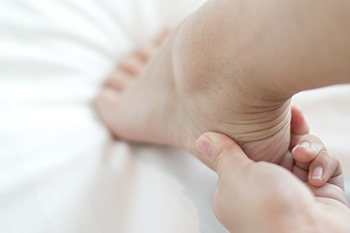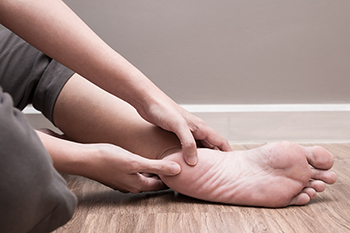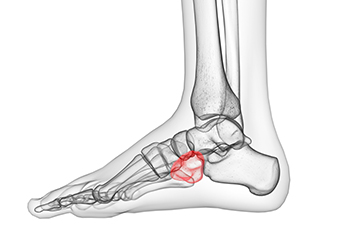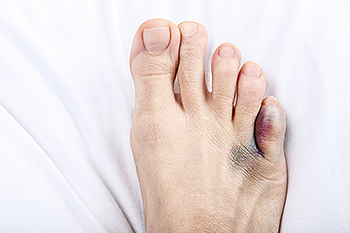Items filtered by date: August 2022
Sever's Disease Affects Children and Young Teenagers

A common condition that can affect children and young teenagers who actively participate in sporting activities is known as Sever’s disease. This is an ailment that affects the heels, and can develop as a result of a heel growth spurt. The heel pain is caused by tight calf muscles or Achilles tendon, and the pain may increase when their chosen activities are pursued. You may notice your child is limping, walking on their toes, or experiencing swelling surrounding the heel. These symptoms may be indicative of Sever’s disease. It is beneficial to wear shoes that fit correctly, and this may help the affected foot to feel better. Effective treatment starts with stopping the activity that caused the condition. It is also important to elevate the foot as often as possible. The average recovery time for Sever’s disease is approximately 2-3 months. If your child has these symptoms, it is advised that you consult with a podiatrist who can effectively diagnose and offer treatment solutions.
Sever's disease often occurs in children and teens. If your child is experiencing foot or ankle pain, see one of our podiatrists from Foot Care Centers of Palm Beach. Our doctors can treat your child’s foot and ankle needs.
Sever’s Disease
Sever’s disease is also known as calcaneal apophysitis, which is a medical condition that causes heel pain I none or both feet. The disease is known to affect children between the ages of 8 and 14.
Sever’s disease occurs when part of the child’s heel known as the growth plate (calcaneal epiphysis) is attached to the Achilles tendon. This area can suffer injury when the muscles and tendons of the growing foot do not keep pace with bone growth. Therefore, the constant pain which one experiences at the back of the heel will make the child unable to put any weight on the heel. The child is then forced to walk on their toes.
Symptoms
Acute pain – Pain associated with Sever’s disease is usually felt in the heel when the child engages in physical activity such as walking, jumping and or running.
Highly active – Children who are very active are among the most susceptible in experiencing Sever’s disease, because of the stress and tension placed on their feet.
If you have any questions, please feel free to contact our office located in Boynton Beach, FL . We offer the newest diagnostic and treatment technologies for all your foot and ankle injuries.
Typical Pregnancy Foot Problems

Although it might not seem immediately intuitive to some pregnant women, pregnancy can seriously impact and affect the feet. While a baby grows inside a pregnant woman, the woman’s center of gravity changes, forcing the feet to adapt. Additionally, during pregnancy, the woman produces a variety of pregnancy hormones that can have significant effects on the feet. One typical problem that you might encounter during your pregnancy is flat feet. Flat feet occur when the feet lose their natural arch and the entire foot presses directly against the ground when standing. Pregnant women can sometimes develop flat feet because as they gain a notable amount of weight, they exert more and more pressure on the feet, which can reduce the arch in the feet. Secondly, another common pregnancy foot problem is swelling in the feet. Swollen feet can frequently occur in pregnant women because, throughout the pregnancy, the pregnant woman’s body must produce a significantly larger amount of blood to support the growing baby. This excess of blood and fluids might sometimes lead to swelling in the feet. As a result, you might notice your foot size increasing, causing your feet to temporarily require larger shoes. If you are pregnant, it might be a good idea to reach out to your podiatrist who can help you manage symptoms on your feet.
Pregnant women with swollen feet can be treated with a variety of different methods that are readily available. For more information about other cures for swollen feet during pregnancy, consult with one of our podiatrists from Foot Care Centers of Palm Beach. Our doctors will attend to all of your foot and ankle needs.
What Foot Problems Can Arise During Pregnancy?
One problem that can occur is overpronation, which occurs when the arch of the foot flattens and tends to roll inward. This can cause pain and discomfort in your heels while you’re walking or even just standing up, trying to support your baby.
Another problem is edema, or swelling in the extremities. This often affects the feet during pregnancy but tends to occur in the later stages.
How Can I Keep My Feet Healthy During Pregnancy?
- Wearing orthotics can provide extra support for the feet and help distribute weight evenly
- Minimize the amount of time spent walking barefoot
- Wear shoes with good arch support
- Wear shoes that allow for good circulation to the feet
- Elevate feet if you experience swelling
- Massage your feet
- Get regular, light exercise, such as walking, to promote blood circulation to the feet
If you have any questions please feel free to contact our office located in Boynton Beach, FL . We offer the newest diagnostic and treatment technologies for all your foot and ankle needs.
Heel Pain Can Be Treated!
How the Heel Works

The heel is an integral part of your foot, and it plays an important role in helping the foot function. The heel is located at the back of the foot, and it is situated just below the ankle. The heel also sits right behind the arch of the foot. The heel is primarily composed of the calcaneus bone, which has a rectangular shape, and it is supported underneath by a fat padding and thick skin. In terms of biomechanics, the heel has two interesting and critical functions. First, when standing upright on both feet, a person is aided by the heel because it serves as a kind of weight-bearing support unit. In other words, the heel is stabilizing and protective. Second, when an individual is engaging in physical activities that involve motion (such as walking, running, or jumping), the heel acts as a type of lever which engages muscles in the calf. Taking care of the heel is important. Not only can the skin surrounding the heel become damaged through a condition known as cracked heels, the heel bone can also suffer from afflictions such as heel spurs. If you want to learn more about heels and how you can protect them, contact a trusted podiatrist.
If you have any concerns about your feet, contact one of our podiatrists from Foot Care Centers of Palm Beach. Our doctors can provide the care you need to keep you pain-free and on your feet.
Biomechanics in Podiatry
Podiatric biomechanics is a particular sector of specialty podiatry with licensed practitioners who are trained to diagnose and treat conditions affecting the foot, ankle and lower leg. Biomechanics deals with the forces that act against the body, causing an interference with the biological structures. It focuses on the movement of the ankle, the foot and the forces that interact with them.
A History of Biomechanics
- Biomechanics dates back to the BC era in Egypt where evidence of professional foot care has been recorded.
- In 1974, biomechanics gained a higher profile from the studies of Merton Root, who claimed that by changing or controlling the forces between the ankle and the foot, corrections or conditions could be implemented to gain strength and coordination in the area.
Modern technological improvements are based on past theories and therapeutic processes that provide a better understanding of podiatric concepts for biomechanics. Computers can provide accurate information about the forces and patterns of the feet and lower legs.
Understanding biomechanics of the feet can help improve and eliminate pain, stopping further stress to the foot.
If you have any questions please feel free to contact our office located in Boynton Beach, FL . We offer the newest diagnostic and treatment technologies for all your foot and ankle needs.
When the Cube-shaped Bone in Your Foot Becomes Dislocated

On the outer side of the foot in front of the heel, lies the cuboid bone. This cube-shaped structure helps connect the foot to the ankle, provides the feet with stability, and helps dissipate the mechanical force it bears while walking and standing. The cuboid bone can become dislocated, which is known as cuboid syndrome, or cuboid subluxation. This can occur as a secondary injury of a sprained ankle, excessive strain on the area, or if the foot rolls inward repetitively. Flat feet and osteoporosis can also contribute to an occurrence of cuboid syndrome. Cuboid syndrome can cause pain, tenderness, redness and swelling on the outside of the foot, and it may be difficult to move the ankle. Maintaining a healthy body weight, stretching before any physical activity is undertaken, and wearing properly fitted shoes can all reduce the risk of cuboid syndrome occurring. Check with a podiatrist for additional preventative methods, or to have the condition properly diagnosed and treated.
Cuboid syndrome, also known as cuboid subluxation, occurs when the joints and ligaments near the cuboid bone in the foot become torn. If you have cuboid syndrome, consult with one of our podiatrists from Foot Care Centers of Palm Beach. Our doctors will assess your condition and provide you with quality foot and ankle treatment.
Cuboid syndrome is a common cause of lateral foot pain, which is pain on the outside of the foot. The condition may happen suddenly due to an ankle sprain, or it may develop slowly overtime from repetitive tension through the bone and surrounding structures.
Causes
The most common causes of cuboid syndrome include:
- Injury – The most common cause of this ailment is an ankle sprain.
- Repetitive Strain – Tension placed through the peroneus longus muscle from repetitive activities such as jumping and running may cause excessive traction on the bone causing it to sublux.
- Altered Foot Biomechanics – Most people suffering from cuboid subluxation have flat feet.
Symptoms
A common symptom of cuboid syndrome is pain along the outside of the foot which can be felt in the ankle and toes. This pain may create walking difficulties and may cause those with the condition to walk with a limp.
Diagnosis
Diagnosis of cuboid syndrome is often difficult, and it is often misdiagnosed. X-rays, MRIs and CT scans often fail to properly show the cuboid subluxation. Although there isn’t a specific test used to diagnose cuboid syndrome, your podiatrist will usually check if pain is felt while pressing firmly on the cuboid bone of your foot.
Treatment
Just as the range of causes varies widely, so do treatments. Some more common treatments are ice therapy, rest, exercise, taping, and orthotics.
If you have any questions, please feel free to contact our office located in Boynton Beach, FL . We offer the newest diagnostic and treatment technologies for all your foot care needs.
Pain in the Pinky Toe

Pain in the fifth toe, commonly referred to as the pinky toe, can be quite problematic. Although the pinky is the smallest of all the toes on the feet, pinky toe pain can be uncomfortable nonetheless. Since this toe is located on the outside of the foot, the pinky toe can be especially prone to stubbing and injuries. If you are experiencing pain in the pinky toe, there could be any number of causes. First, you might have broken or fractured the pinky toe. Broken toes will sometimes release a popping sound when impacted. X-rays might be needed to analyze the toe and its fracture. Another potential cause of pinky toe pain is ill-fitting footwear that makes the pinky toe rub up against the shoe. Lastly, pinky toe pain can be caused by the development of a corn. Similar to a thick, hardened callus, corns on the pinky toe can be painful when they are rubbed against the inside of a pair of shoes. Pain in the pinky toe is no joke — it is suggested you see a podiatrist who can help you address the problem.
Toe pain can disrupt your daily activities. If you have any concerns, contact one of our podiatrists of Foot Care Centers of Palm Beach. Our doctors can provide the care you need to keep you pain-free and on your feet.
What Causes Toe Pain?
Most severe toe pain is caused due to a sports injury, trauma from dropping something heavy on the toe, or bumping into something rigid. Other problems can develop over time for various reasons.
Toe pain can be caused by one or more ailments. The most common include:
- Trauma
- Sports injury
- Wearing shoes that are too tight
- Arthritis
- Gout
- Corns and calluses
- Hammertoe
- Bunions
- Blisters
- Ingrown toenails
- Sprains
- Fractures (broken bones)
- Dislocations
When to See a Podiatrist
- Severe pain
- Persistent pain that lasts more than a week
- Signs of infection
- Continued swelling
- Pain that prevents walking
Diagnosis
In many cases the cause of toe pain is obvious, but in others, a podiatrist may want to use more advanced methods to determine the problem. These can range from simple visual inspections and sensation tests to X-rays and MRI scans. Prior medical history, family medical history, and any recent physical traumatic events will all be taken into consideration for a proper diagnosis.
Treatment
Treatments for toe pain and injuries vary and may include shoe inserts, padding, taping, medicines, injections, and in some cases, surgery. If you believe that you have broken a toe, please see a podiatrist as soon as possible.
If you have any questions please feel free to contact our office located in Boynton Beach, FL . We offer the newest diagnostic tools and technology to treat your foot and ankle needs.

